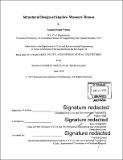| dc.contributor.advisor | John Ochsendorf. | en_US |
| dc.contributor.author | Wilson, Samuel Hodin | en_US |
| dc.contributor.other | Massachusetts Institute of Technology. Department of Civil and Environmental Engineering. | en_US |
| dc.date.accessioned | 2016-09-13T19:17:08Z | |
| dc.date.available | 2016-09-13T19:17:08Z | |
| dc.date.copyright | 2016 | en_US |
| dc.date.issued | 2016 | en_US |
| dc.identifier.uri | http://hdl.handle.net/1721.1/104248 | |
| dc.description | Thesis: M. Eng., Massachusetts Institute of Technology, Department of Civil and Environmental Engineering, 2016. | en_US |
| dc.description | Cataloged from PDF version of thesis. | en_US |
| dc.description | Includes bibliographical references (pages 53-54). | en_US |
| dc.description.abstract | This thesis investigates the viability of shallow, unreinforced masonry domes for the roof and floor systems of residential construction. In recent years, reinforced concrete (RCC) framed construction has been established as the dominant structural form for residential and commercial usage in the developing world, with the flat two-way slab as the most common (almost universal in northern India) spanning solution for these designs. Over the same time period, local artisans in the Muzzafarnagar region of Uttar Pradesh in northern India have combined shallow brick vaulting techniques with an RCC tension ring as a small to medium scale spanning solution. While these vaults are a cost-effective alternative to a concrete slab roof/floor system, improperly designed and detailed masonry construction can prove dangerous, especially in seismic zones. This thesis is an exploration of the structural behavior and design of these domes, intended to produce broadly applicable design guidelines to ensure the strength and stability of this structural typology in order to valorize their broad usage, where appropriate, in India's housing sector. Simplified design calculations for unreinforced masonry which match experimental data are generated using equilibrium methods and plastic design theory. Influence of geometric and material parameters on strength and stability are investigated, and discussion of proper detailing and the limitations of this spanning technology is included. | en_US |
| dc.description.statementofresponsibility | by Samuel Hodin Wilson. | en_US |
| dc.format.extent | 81 pages | en_US |
| dc.language.iso | eng | en_US |
| dc.publisher | Massachusetts Institute of Technology | en_US |
| dc.rights | M.I.T. theses are protected by copyright. They may be viewed from this source for any purpose, but reproduction or distribution in any format is prohibited without written permission. See provided URL for inquiries about permission. | en_US |
| dc.rights.uri | http://dspace.mit.edu/handle/1721.1/7582 | en_US |
| dc.subject | Civil and Environmental Engineering. | en_US |
| dc.title | Structural design of shallow masonry domes | en_US |
| dc.type | Thesis | en_US |
| dc.description.degree | M. Eng. | en_US |
| dc.contributor.department | Massachusetts Institute of Technology. Department of Civil and Environmental Engineering | |
| dc.identifier.oclc | 958144521 | en_US |
